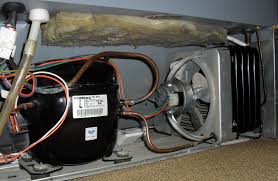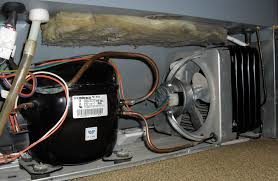Our topic of discussion is Coolant liquid refrigerant, commonly called antifreeze. Basically it is a mixture of ethylene and water or propylene glycol and water in 50/50 ratio. Coolant is a special fluid with additives, because it has to remain liquid at very low temperatures (below 0°C) but must not evaporate at high-temperatures (above 100°C).
Definition of Coolant liquid refrigerant :
Contents
A fluid which flows through or around a mechanical device like AC to prevent its overheating by transferring the produced heat to other devices is called coolant liquid refrigerant. The coolant absorbs the heat from the machine and then eventually dissipates it through the radiator.
Properties of an ideal coolant:
- High thermal capacity,
- Low viscosity
- Non-toxic
- Chemically inert
- non-flammable
Types of coolant:
There are mainly 3 types of antifreeze.
- GREEN COOLANT: These are the oldest types of antifreeze. They are mostly used in North America. They are made of silicate and phosphate composition which is used to provide protection for aluminum and iron surfaces.
- OAT COOLANT: Full form of OAT is Organic Acid Technology. OAT coolant contains ingredients such as 2-EHA and various kinds of organic acids. They generally do not contain silicates or phosphates compounds.
- HOAT COOLANT: HOAT meant Hybrid OAT. They contain organic acids except for 2-EHA. Also, silicates are provided to make protection for aluminum surfaces.
Nowadays, antifreeze manufacturers are creating “universal antifreeze” which can be used with all types of mechanisms.
Uses:
Mostly coolant liquid refrigerant is used in all kinds of AC units and they are called AC Refrigerants.
WARNING: It is very much important to know about an AC refrigerant in an AC because the unit of current is very much dependent on a coolant.
Important features of Coolant liquid refrigerant:
Coolant is very much vital for the mechanical operation of the Air Conditioner and engine. A modern antifreeze needs the following features.
- Corrosion prevention
- High-quality heat transfer
- Firm protection from freezing
- Scale build-up prevention
- Compatibility with hard water
- Stability at a flexible temperature
- Low foaming
All of these properties make a coolant perfect and one of the perfect AC refrigerants is FREON. Basically it is a trademark of a well-known company THE CHEMOURS. Freons are very low toxic, stable and nonflammable gases which have refrigerant properties. In AC they are used mostly. Long term time, Freon is used for home AC.

Freon for home Air Conditioner:
Freon for home AC is mainly Fluorinated aliphatic organic compounds. are a colourless and odorless substance that is nonflammable and nontoxic gas or liquid. Their boiling point and surface tension are low and low viscosity make them a perfect coolant liquid refrigerator.
Most important coolants which are used in home AC are
- Trichlorofluoromethane – Freon 11
- Dichlorofluoromethane – Freon 12
- Chlorodifluoromethane – Freon 22
- Trichlorotrifluoroethane – Freon 113
- Dichlirotetrafluoroethane – Freon 114
[R-12 Freon is used for car air conditioner]
Nowadays the most common Freon Chlorofluorocarbons (CFCs) are not used in home ACs because they can make holes in the ozone layer. So hydrochlorofluorocarbons (HCFCs) and Hydrofluorocarbons (HFCs) are used as Freon for home Air Conditioners. Those are safe freons and can’t make holes in the ozone layer. It is safe to use home AC made of this type of freon. There is another new class of Freon named Hydrofluoroolefin (HFOs).
HCFCs: This type of freon for home AC contains less amount of chlorine and for that, they are not that much harmful.
HFCs: This type of freon for home AC contains no chlorine and is totally safe for the ozone layer.
HFOS: This type of freon for home AC contains propylene molecules and an unsaturated carbon bond which is named olefin.
NOTE: ac with HCFC antifreeze can work 60% more than AC containing HFC coolant.
FREON 22, KNOWN AS R22 OR HCFC-22 IS THE MOST USED FERON IN OLD ACs. IT IS AN IDEAL FREON FOR MAKING HOME AIR CONDITIONERs.
Coolant liquid refrigerant for home ACs:
Though it is thought that AC Refrigerant is safer than Freon for home Air Conditioner, a huge amount of AC refrigerant is being used in high-quality home ACs.
There are some Refrigerant for home Air Conditioners such as
- R-134A: It is a haloalkane refrigerant which has thermodynamic properties.
- R-407C: It contains polyol ester oil and can use nitrogen as holding charge.
- R-404A: It is an azeotropic blend of some refrigerants like R-143A, R-125, and R-134A.
- R-410A: It is also an azeotropic blend containing R-32 and-125.
- R-600A: It is a compound of isobutene.
- R-290: It contains hydrocarbons like propane.
Nowadays R-410A IS APPROVED AS THE SAFEST REFRIGERANT FOR HOME AIR CONDITIONERS. IN CASE OF SPLIT AC IT IS USED GRADUALLY.
FAQs:
Q. Which freon is banned for home ac?
Ans: R-11 is banned because of its ability to make holes in the Ozone layer, it is a very common CFC gas. It is not used in recent ACS.
Q. Can any antifreeze replace Freon?
Ans: Beginning of this year 2020, most of the production of Freon is stopped because of environmental awareness. So HCFC-22 is used for replacing Freon.
Q. What kind of gas is used in making coolant?
Ans: Mainly HCFCs and HFCs are used in current time ACs.
Q. What are the signs of your AC if the refrigerant is low?
Ans: There are some signs which are shown when AC has low coolant,
- Electric bill increases
- Indoor temperature doesn’t become comfortable
- Ice buildup in the outer unit
- Some noise like hissing when the AC is on.
Q. When to flush coolant?
Ans: Over its time, coolant loses its properties. Then we should flush them.
Warning: Radiator fluid is toxic.
Q. Which time we can flush a coolant?
Ans: The coolant should only be changed when the mechanism is totally cool or switched off for a few hours. It takes approximately 30 minutes to drain the coolant completely.
Q. How to do a coolant flush?
Ans: We should have to know that used coolant should not be disposed of openly in the drain or wastewater systems. We have to Ans bother about the appropriate coolant waste collection.

